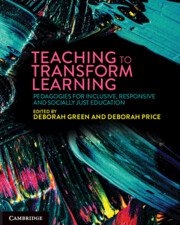Book contents
- Teaching to Transform Learning
- Acknowledgement of Country
- Teaching to Transform Learning
- Copyright page
- Contents
- Contributors
- Acknowledgements
- Introduction Understanding the learner to inform educators’ implementation of pedagogical approaches to transform learning
- Part 1 Pedagogies for all
- Part 2 Engaging pedagogies: making the curriculum come alive for all learners
- 8 Redesigning pedagogy for transformation: creative body-based learning
- 9 Building transformative classrooms through visual and creative body-based learning design
- 10 Co-constructed early childhood pedagogies
- 11 Strengths-based, learner-centred pedagogies: the voice of learners in co-creation and co-design
- 12 Pedagogy informed by community expertise
- 13 Nature-based approaches enhancing experiential learning
- 14 Beyond the four walls
- Part 3 Empowering pedagogies: 21st-century skill development and 22nd-century futures thinking
- Index
- References
10 - Co-constructed early childhood pedagogies
from Part 2 - Engaging pedagogies: making the curriculum come alive for all learners
Published online by Cambridge University Press: 25 October 2024
- Teaching to Transform Learning
- Acknowledgement of Country
- Teaching to Transform Learning
- Copyright page
- Contents
- Contributors
- Acknowledgements
- Introduction Understanding the learner to inform educators’ implementation of pedagogical approaches to transform learning
- Part 1 Pedagogies for all
- Part 2 Engaging pedagogies: making the curriculum come alive for all learners
- 8 Redesigning pedagogy for transformation: creative body-based learning
- 9 Building transformative classrooms through visual and creative body-based learning design
- 10 Co-constructed early childhood pedagogies
- 11 Strengths-based, learner-centred pedagogies: the voice of learners in co-creation and co-design
- 12 Pedagogy informed by community expertise
- 13 Nature-based approaches enhancing experiential learning
- 14 Beyond the four walls
- Part 3 Empowering pedagogies: 21st-century skill development and 22nd-century futures thinking
- Index
- References
Summary
Early childhood education as a field has heavily relied on theories from developmental psychology since the 19th century to inform pedagogy and practice. The use of developmental theories has been significant in assisting the field to raise its professional status, however, an over-reliance on these theories alone has contributed to marginalising children with rich cultural, linguistic and religious diversities. This chapter will focus on exploring co-constructed pedagogies as creating inclusivity in early childhood education (birth to age 8). In particular, co-constructed pedagogies engage children, educators/teachers, families and community in dialogue to inform curriculum and practices that reflect diverse learning communities. It is argued that co-constructed pedagogies are not only important in early childhood education but also offer insights that can support inclusivity in primary and secondary education.
Keywords
- Type
- Chapter
- Information
- Teaching to Transform LearningPedagogies for Inclusive, Responsive and Socially Just Education, pp. 152 - 170Publisher: Cambridge University PressPrint publication year: 2024

